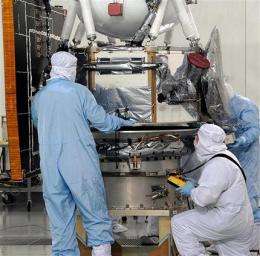NASA to launch sky-mapping spacecraft

(AP) -- NASA's latest space telescope will scan the sky in search of never-before-seen asteroids, comets, stars and galaxies, with one of its main tasks to catalog objects posing a danger to Earth. The sky-mapping WISE, or Wide-Field Infrared Survey Explorer, is scheduled to launch no earlier than before dawn Friday from Vandenberg Air Force Base on the central California coast aboard a Delta 2 rocket.
If all goes as planned, WISE will orbit some 325 miles above the Earth and produce the most detailed map yet of the cosmos. It is designed to detect objects that give off infrared light or heat. Infrared light is ideal for uncovering dusty, cold and distant objects that often can't be seen by optical telescopes.
The mission is expected to find millions of hard-to-see objects, said principal investigator Edward Wright of the University of California, Los Angeles.
"It's really a mission to survey everything that's out there," Wright said. "What we're trying to do is make a map of the universe."
Scientists estimate it will take six months for WISE to peruse the entire sky. The spacecraft will circle the Earth 15 times a day and take about 7,500 images a day in four infrared wavelengths.
WISE will catalog the locations and sizes of near-Earth objects such as asteroids and comets that could threaten Earth.
The spacecraft will also look for failed stars called brown dwarfs, gaseous balls that never quite gathered enough mass to set off the nuclear fires that cause stars to shine. Also of interest are galaxies that shine with the brilliance of more than a trillion suns.
The $320 million mission, managed by NASA's Jet Propulsion Laboratory, should help current and future spacecraft zero in on the most interesting objects for detailed studies.
WISE will join two currently operating infrared space telescopes - NASA's Spitzer Space Telescope and the European Space Agency's Herschel Space Observatory. Both differ from WISE by focusing on specific celestial targets.
Project managers say WISE will be hundreds of times more sensitive than its predecessor, the Infrared Astronomical Satellite, launched in 1983. The joint U.S.-British-Dutch mission discovered six comets and detected huge discs of dust surrounding several distant stars.
The Infrared Astronomical Satellite studied the cosmos for 10 months until it ran out of coolant. WISE is expected to meet the same fate.
On the Net: WISE mission: http://www.jpl.nasa.gov/wise/
©2009 The Associated Press. All rights reserved. This material may not be published, broadcast, rewritten or redistributed.




















